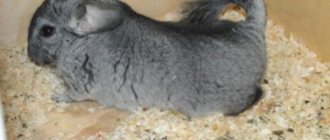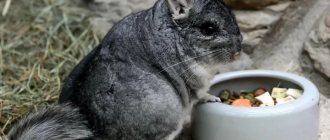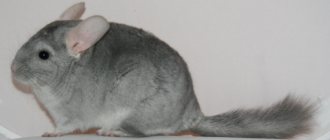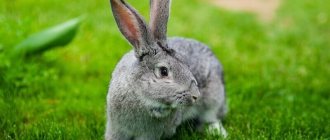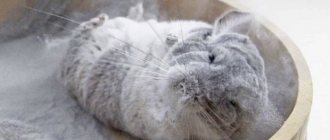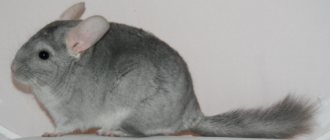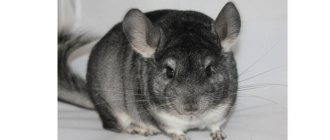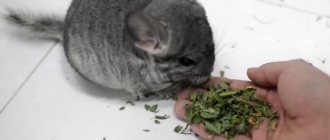The chinchilla breeding business is quite attractive by many criteria and guarantees high profits.
This business is based on breeding animals and selling both them and the most precious fur in the world. A breeding animal can be sold for approximately $100.
To organize a business you will need to answer certain questions. How much do chinchilla skins cost? What is the initial investment and possible profit? We will talk about this and much more further.
To organize activities, you will need to draw up a project that considers all the nuances of the work of the upcoming company. A chinchilla breeding business plan includes the main areas: organizational, financial, legal and others.
Business plan for breeding chinchillas at home
It is quite possible to breed these animals in small quantities at home in a one-room apartment, or in private households. Keeping chinchillas at home for business purposes does not require large areas or special conditions.
Animals do not emit an unpleasant odor due to the absence of sweat and sebaceous glands, and their fur does not shed like other animals. They are very friendly, they do not bite or scratch, they even gnaw their claws on their own. As for the equipment, it includes cages that can be easily made independently or purchased at zoo outlets.
Difficulties and their solutions
The chinchilla is a very clean animal and demanding in care, food and maintenance. Here are a few difficulties that you may encounter, and in parentheses the solution to the problem.
- Animals take a long time to adapt , they are afraid of people (the first 10 days they get used to new conditions, this is a normal phenomenon. You just need to provide them with water, food and dim the lights . Leave them alone while they adapt);
- They eat poorly and do not grow (perhaps compound feed is not suitable for them, give more hay and change the food to another. Buy a specialized grain mixture for chinchillas );
- The mating is unsuccessful (this means that the chinchilla has not yet grown to childbearing age. And if you do not understand when a chinchilla comes into heat, give the boy access to all chinchillas . He will run around the cages and fertilize all the chinchillas that come into heat);
- Puppies die (lack of milk from the mother; when 4 puppies are born, some of them are born weak or underdeveloped, this is considered normal. And if puppies die in all chinchillas at about the same time, there is a risk that there is an infection on your farm. B In this case , all chinchillas need to be transplanted and the cells must be thoroughly disinfected and the sawdust changed );
There seem to be few difficulties, but they exist, and they need to be solved as necessary.
We advise you to read: How to earn 1,000,000 rubles on your own land in a village where there is no work.
Expenses
1. Buying chinchillas. The price of one individual is about 6-9 thousand rubles. For 3-4 females, one male is needed.
2. Equipment. Acquisition of cells. The maintenance area is required to be small in size. Up to 20 animals can freely fit in an area of 2 square meters.
The cells are placed on top of each other, so little space is required.
A cage of 30x40 cm is enough for one animal. They are made independently, to order, or purchased in stores. The cost of a cage can be from 1500 to 10 thousand rubles.
3. Nutrition. In one month, one individual consumes up to 0.7-1 kg of dry food, at a cost of up to 20 rubles per kilogram. It is possible to prepare food yourself, which will significantly reduce costs (hay, dried dandelion leaves).
Chinchilla is an extremely profitable animal. Anti-crisis program
Keeping chinchillas today may well become a profitable business for a farmer, a pensioner, a schoolchild, a student, and even for people with disabilities.
Chinchilla cages
The size of the cage for keeping a pair of adult animals with offspring is 50x50x50 cm. As a room for keeping, you can use a room in the house or a dry, well-ventilated room in an outbuilding.
The windows of a room with a large number of cells should face east or west, and rows of cells should be installed along the windows so that they are all equally illuminated. It is important to cover the windows with insect screens to keep flies out.
Breeding conditions
The room temperature should be maintained at +18-20°C, although the chinchilla easily tolerates low temperatures and feels good in a dry room at temperatures just above zero. High humidity at low temperatures contributes to the development of fungal diseases, decreased fertility, increased feed consumption and, in extreme cases, leads to mortality.
Chinchilla does not like sharp, unexpected sounds. Animals react to them with increased nervousness, aggression, and periodic infertility. The animals quickly get used to constant monotonous sounds and noises.
The main equipment of the cages are glass or ceramic bowls and glasses; they are heavy, they are not so easy to turn over, and animals do not chew them.
Food for chinchillas
The chinchilla is a herbivore; in natural conditions it is content with very poor plant food, which is dry for most of the year. Therefore, on farms, their feeding is based on dry feed - this is hay, as well as cereals in the form of corn, wheat, and Hercules oat flakes. Dry twigs of apple, willow, willow, rose hips and hawthorn.
Reproduction
Chinchilla is a polygamous animal. In the wild, there are from three to seven females per male. When keeping cages, it is best to keep chinchillas in pairs (one male + one female). With this type of maintenance, after the birth of the puppies, there is no need to remove the male from the cage. Within a week after the birth of the offspring, the female mates with the male.
Chinchillas reproduce slowly compared to, say, rabbits. It is believed that under optimal housing conditions, one average female can produce 3-5 chinchillas per lamb, up to three times a year. Pregnancy in chinchillas lasts, on average, 105-117 days.
Business areas
There are two main directions for selling chinchilla products. The first and most profitable is the sale of animals from 2 to 6 months for further breeding. The result is a profitability of up to 50%. The second is the sale of live chinchillas for skins (from 6 months to 18-20 years). Selling animals for skins allows us to confidently make a profit of up to 60%. Hence the conclusion that selling chinchillas for skins is economically profitable and profitable.
The sale of live animals for breeding purposes is the main business for fur farmers in Russia for the next 20 years, and sales for skins is a related business. Both directions have already been mastered by thousands of chinchilla breeders from different countries, and it’s up to chinchilla breeders from Russia.
Chinchilla was taken from us not only throughout Russia, but also in Azerbaijan, Armenia, Georgia, Turkey, Kazakhstan, Uzbekistan, Turkmenistan, Iran. But, as in any other type of business, it is necessary to conduct business more skillfully and carefully.
Subtleties of business
Here are just a few real examples showing how easy it is to get caught in the cunningly arranged networks of chinchilla dealers in our time.
Recently, young enterprising people from Kazakhstan and Kyrgyzstan called me and offered to develop their market, explaining that they are located next to China and supplying animals to this country is very profitable and profitable. A tempting offer?
But let's think a little: this country has a population of one and a half billion, and since 2015 families are allowed to have not one child, but two, that is, the population will double. The standard of living in the Middle Kingdom cannot possibly be higher than in Russia.
What kind of chinchillas are there - here you need to think about your daily bread. Everyone also knows that chinchillas are brought to us from China, and not vice versa. I will simply lose money and time establishing chinchilla trade with China.
At the beginning of January 2016, a call came from Crimea. Farmers called who managed to purchase a batch of breeding chinchillas in Sevastopol and they would like to sell the animals for fur coats in Russia, since the border with Ukraine is closed and there is no longer any sale of “fallow” chinchillas.
I tried to explain to them that chinchilla was brought to us and is now being imported mainly from Ukraine, from Lvov. This is a chinchilla that was subject to so-called close crossing, and it is not suitable for skin at all. Everything that was once brought from Lvov now goes along established routes to Crimea and Sevastopol.
After all, before a chinchilla is slaughtered for its skin, it is left indoors for 45 days, where it is alone in a cage. It is bathed in baths with sand and talc to give the skin shine and cleanliness. The air temperature from 23°C is lowered to 3-4 degrees within 45 days, and only then the slaughter and subsequent dressing of the skin are carried out using electric shock and other exotic types of slaughter.
This is a very, very labor-intensive process. And the chinchilla, where close crossing was allowed, especially in the regions of western Ukraine, will not withstand a drop in temperature for 45 days. And, as the Russians say, it will quickly “glue its fins together” and most of the livestock will not live to see slaughter. That is why it is necessary to take a chinchilla from large or medium-sized nurseries, so that this chinchilla can then be quickly sent for skinning.
Finding a free niche for business
In modern economic conditions and the market as a whole, to start a business you need to look for unoccupied production niches. One of these is chinchilla breeding. Let's try to figure out what's what and what's required for this. To do this, we will consider a ready-made business plan, as well as the conditions for their maintenance and breeding at home.
As you know, the chinchilla is a fur-bearing herbivore animal, which, subject to certain conditions, can be kept in latitudes from the city of Sochi to the cities of Norilsk and Magadan. Chinchillas are kept as a pet (for children, in pet corners, offices, and so on).
Organization of a mini-farm
You can organize a mini-farm for breeding chinchillas “Mini-farm for breeding chinchillas for 6 pairs of adult chinchilla animals” on the glassed-in balcony of a 17-story building. So, on the eleventh floor of an 11-story residential building in Taganrog, pensioners in one room and on the balcony keep 80 pairs of adult chinchilla animals.
An adult eats 8–12 kg per year. stern. It is necessary that there is always water in the cage and that the cage is cleaned and cleaned once every two weeks, and that the entire cage is disinfected once every 2–3 months.
For a starting business, you need to try breeding with 6 pairs (12 individuals) of adult animals. Let’s say you have acquired 6 families, you are going to raise a chinchilla in a house, apartment, barn, garage or greenhouse, in your own premises, saving on rent. The chinchilla is fed once a day, and it will take you only 10 - 15 minutes a day. One breeding individual costs, depending on age, from 3,500 to 4,500 rubles. Chinchillas live 15–21 years, and reproduce very well until they are 9–12 years old.
You can make cells yourself, on your own (there’s nothing complicated about it). 12 chinchillas X 4,500 rubles = 54,000 rubles – the cost of purchasing a chinchilla. A chinchilla breeds 3 times a year and produces an average of 2–4 offspring. It turns out 9 animals from one pair: 9X6 = 54 animals. 54 chinchillas, if sold at 2-3 months of age, then one animal costs 2,000 rubles. If at 6 months of age - 3,500 rubles. If with a pregnant female at 1 - 3 - 4 years of age - it costs 4,500 rubles per animal.
Everyone must calculate for themselves how many animals they can support. I will say, for example, that a year ago in Rostov-on-Don a young family bought 6 pairs of chinchillas. During the year they earned 240,000 rubles in net profit. The young chinchilla they had from lambing 1 and 2 also brought small chinchilla animals. These fluffy animals with very valuable fur are more profitable than rabbits, since there is practically no mortality, like in rabbits, they do not need to be fed with meat, like a sable, ferret or mink. A chinchilla takes up very little space and requires no upfront costs.
Cages for keeping chinchillas in pairs (when sold, we give each family free of charge, as well as an author’s book on breeding and keeping animals). At the moment, during the crisis, many people who worked with mushrooms, quails, rabbits or nutria are switching to chinchilla breeding. Very low feed consumption and no costs for large premises and paddocks once again prove the effectiveness and economic benefits of breeding and selling chinchillas.
In conclusion, I would like to emphasize that we do not have any representatives in the regions; we work directly, without intermediaries. If in any Russian region someone claims that they represent our interests, you should know that they are scammers. I will send the author’s book “Chinchilla – a super-profitable animal” for free to everyone who wants it. Anti-crisis program."
Director of the Breeding Nursery “Chinchilla Breeding in the Family Estate” Yu.I. Kharchuk, Krasnodar region, Tel.1, e-mail
Bottom line
Raising chinchillas at home is very profitable and not troublesome. In addition to the fact that they bring very high income, these animals look very beautiful and complement any home. It is more convenient to keep chinchillas in garages or special premises at your own dacha or farm, but at home they, although they will take root, will create a smell and gnaw on everything. However, some even cats behave more aggressively.
In order to delve into the intricacies of keeping, estimate expenses and real income, it is advised to take a couple of chinchillas to a city apartment and watch them for several months. Many of these animals have problems with breeding at home when they do not want to reproduce.
But not with chinchillas - they perfectly produce babies and, depending on luck, can bring not 3-5 newborns, but up to a dozen. This increases the profit and payback of the business almost in the first six months of owning such a farm.
Chinchilla color
The main factor influencing the price is the color of the animal. The natural (standard) color of chinchillas is dark gray. A chinchilla of this color is highly valued if the back and sides have a rich dark color and there is a clearly defined border with a white belly.
The presence of stripes in color can raise the price even higher. But today, many colored chinchillas have been bred, they are bred from four main colors: standard, black velvet, white, beige. They cost an order of magnitude more than standard-colored animals. Because they are hatched in several stages and have a very complex genetic structure. Since their removal is associated with many difficulties and nuances. But when setting the price, many nuances are taken into account, here are the main ones:
- Uniform color in single-color chinchillas.
- The back and sides are uniform and rich in color.
- The back and sides are free of lightening and stains.
Content Features
The chinchilla mini-farm is illuminated using ordinary light bulbs. Heating in winter is electric. Air conditioners are used for cooling in the summer. You can purchase animals using an affiliate program provided by the owners of special farms. There you can order cages and get information on the contents. Actually, what the animal needs: 14-18 degrees, 60% air humidity, sand for swimming, several hundred grams of food per day and a tree with a stone to sharpen its teeth.
Basic costs
1. Premises.
For 250 heads - a space of no more than 30-50 square meters (per 1 sq. m - 12 cells, if arranged vertically).
Options:
- when purchasing premises, the amount is paid one-time;
- when renting - monthly;
- own territories (dacha, private outbuildings) - absolutely free.
2. Purchase of animals - 250 heads (200 females and 50 males) about 1-1.5 million rubles.
3. Feed costs – 50,000 rubles per year.
4. Equipment – cages, accessories. For a wholesale order, the cost will not exceed 100,000 rubles.
5. Staff salary - 100,000 rubles. in year.
Profit
The estimated cost of 1 animal is from 6,000-10,000 rubles. and higher, when selling for exotic purposes - from 10 to 30 thousand rubles.
From the volume of animals that 200 females produce, you can get 10-18 million rubles a year. When selling for exotic purposes, the profit will increase to 60 million. The cost of 1 chinchilla skin in the finished product reaches $1 thousand.
Products for sale:
- Live chinchillas for breeding.
- Skins and fur products.
- Chinchilla meat.
- Live chinchillas as exotic animals and a fashion element.
My chinchilla farm is already 10 years old
Hello dear readers. My name is Elya. I am 45 years old. I live in the Saratov region in the village of Krasnaya Polyana. My chinchilla farm turned 10 years old this year.
How did I find this way to make money?
My cousin lives in the Moscow region, and she breeds chinchillas. She got involved in them to sell the skin, because it is very expensive and in great demand. She invited me to buy 10 chinchillas from her and start breeding them so that I could sell her one-month-old chinchillas. She, in turn, kept them until the required age, and they were slaughtered to sell skins and meat. Without hesitation, I agreed, because at that time I was unemployed and I really needed money.
Search for buyers
Who is the target audience for this business?
- The main buyers can be both existing farmers in the fur market and new entrepreneurs who want to form this direction in their own city. The search is carried out by offering products through the website and advertising. Direct commercial offers for the sale of individuals are also appropriate.
- Functioning pet stores selling such animals.
- City residents purchase animals for exotic purposes as a tribute to fashion. Attraction through advertising in the city. The income is the highest.
- Factories for sewing fur products and selling fur directly.
- Cafes, restaurant complexes, sellers of meat products - when selling meat.
Brief overview of the market
The exact numbers are unknown, but as of 2022, there was one large industrial enterprise, as well as just over a hundred small ones. But if we talk about fur, then most of these small enterprises should not be considered as competitors. The fact is that many people breed chinchillas solely for the purpose of selling live animals.
At one time there was a popular scheme that worked approximately according to the principles of network marketing. The idea was simple: raise animals and sell them to other farms that are just starting out. Of course, such enterprises had no long-term prospects.
The demand for chinchilla fur in Russia is much higher than the supply. But it’s worth making an important caveat: high-quality fur. Low-quality skins are in great demand in Russia (products made from them are much cheaper), but if we talk about the top segment, then this is in less demand. There are two reasons:
- in the studio, the highest quality skins are usually purchased only for specific orders;
- Fur products made from top category chinchilla fur are often preferred to be purchased from European manufacturers.
But in any case, it is better to focus on high quality skins. Even if in Russia the level of supply catches up with the level of demand (which is still a long way off), then farm products can always be sold to European countries.
Bottom line
A chinchilla breeding business plan is undoubtedly quite easy to implement and incredibly profitable. This idea is excellent for starting your own business.
This activity is very easy, simple and does not require huge investments. Mega-high income (400-600%)! Just pay attention to how much chinchilla skins cost. The business involves implementing activities both at home and in the most large-scale way - by setting up a mini-farm. Costs for organizational issues are one-time, and the life expectancy of chinchillas (fertility) is up to 15-18 years. Business involves expansion.
Today it is difficult to find any area with such a huge income and such minimal investment. Undoubtedly, this is a very profitable business! One can only guess why it is very poorly developed in Russia, and the niche is still free.
Description and character of chinchillas
Chinchillas are fairly large rodents with fluffy fur, the length of which can reach 38-40 cm. The animal’s head is round in shape, with medium-sized ears on it. The black eyes of chinchillas have vertical pupils, which helps the rodent navigate the area in the dark. The entire body is covered with soft, warm fur; the animal’s tail is covered with guard hairs. The front legs are five-toed, the hind legs are four-toed, they are stronger and longer than the forelimbs. An adult chinchilla weighs 600-800 g; the standard fur color is considered to be an ash (gray-blue) hue. The animal's belly is usually covered with white fur.
The behavior of a chinchilla depends on the treatment of the owner and his family members. With caring owners, the animal becomes friendly and affectionate. Other qualities of the South American rodent include curiosity, developed intelligence, timidity, talkativeness and activity.
Note! Chinchillas are nocturnal animals; they sleep during the day and are awake at night. Be prepared for constant rustling and “running” around the cage.


